All across the globe, people revere Casey Neistat.
Over the past two decades the 36-year-old, whose eponymous YouTube channel has almost 8 million subscribers and whose videos have more than 1.8 billion (yes, billion) views, has gone from a high-school dropout living in a trailer park to a multi-millionaire entrepreneur living in New York – truly fulfilling the American Dream.
Casey is renowned as ‘cool’, ‘game-changing’ and ‘inspirational’, and praise for his original videos flood social media streams; he ‘raises the bar’, ‘pushes boundaries’ and tells ‘compelling stories’. People describe him as ‘driven’, ‘ambitious’, and ‘a born leader’.
After spending just over two hours with him on a rainy day in Manhattan, I’d agree with the aforementioned, but I’d also add one more description into the mix – that of ‘high-functioning sociopath’.
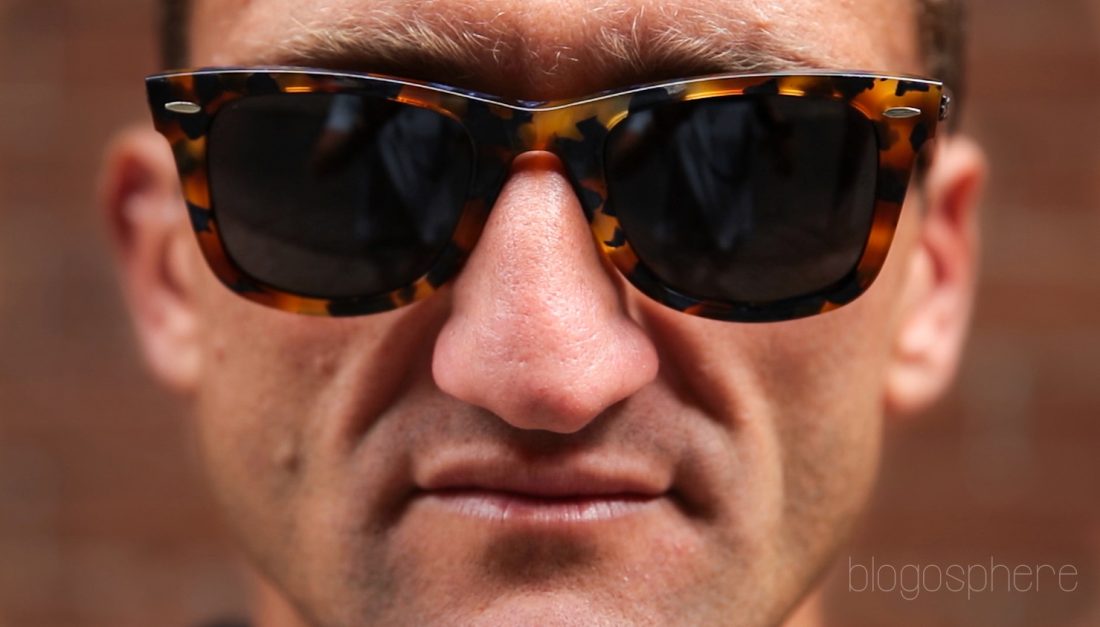
I realise I’ve just branded one of the most famous social media stars in the world with a personality disorder, so before the shit hits this fan, let me explain myself (full disclosure: I am not professionally trained in the study of sociopaths. I am just an avid reader on the subject).
Firstly, not all sociopaths are twisted, evil murderers unable to function within society. Some sociopaths, who according to recent estimates make up 1-4% of the population, are incredibly successful businessmen and women.
Known as ‘high-functioning sociopaths’, their character traits include confidence, fearlessness, intelligence and ruthlessness. They are known to be obsessive, competitive, impulsive and have a strong desire for power.
Indeed, these ‘high-functioning sociopaths’ can often be found in top jobs – surgeons, politicians, editors, CEOs and entrepreneurs. Their exceptional drive and ruthless ambition, combined with their predatory spirit, risk-taking nature and lust for success and recognition give them a competitive advantage on the corporate ladder.
Fictional high-functioning sociopaths include Sherlock Holmes, Miranda Priestly [Runway magazine editor in The Devil Wears Prada], and Jay Gatsby [The Great Gatsby].
Real life suspected high-functioning sociopaths include Oscar award-winning writer and director Quentin Tarantino, Facebook CEO Mark Zuckerberg and Apple co-founder Steve Jobs…
And now YouTuber and entrepreneur Casey Neistat.
So why do I think Casey – one of the most loved creators in the world – is a high-functioning sociopath? Let’s go back to New York.
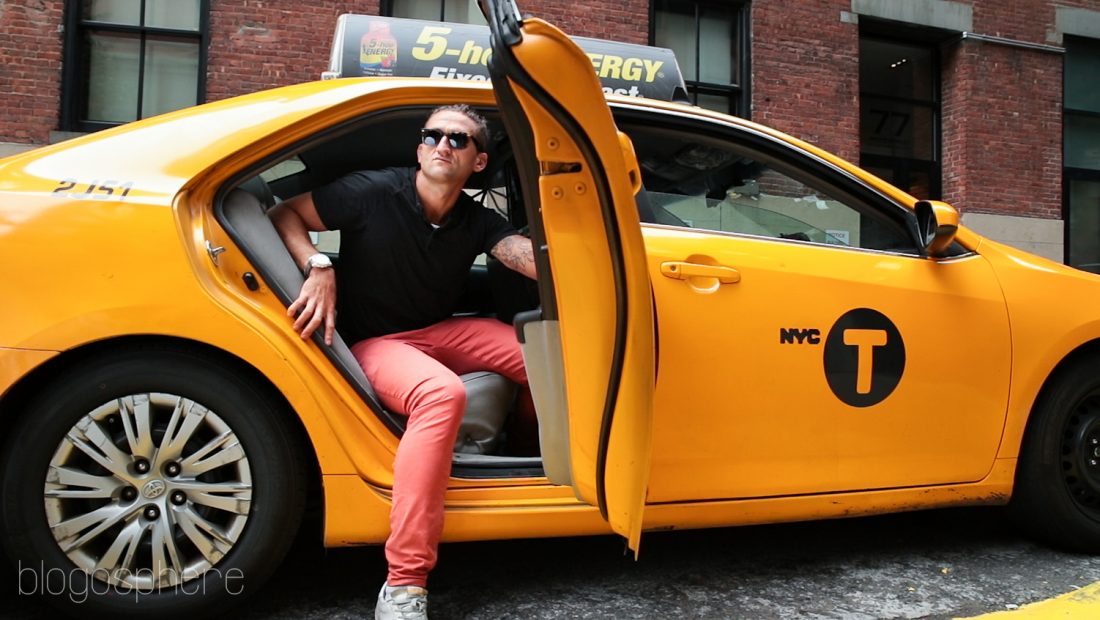
It starts at 3.49am. This is when I receive an email from him asking if we can push the shoot back from 11am to 1pm. Who sends emails at 3.49am?! Who wakes up at 3.49am! Bear in mind that I have flown in from the UK the day before, am jetlagged – and still not awake. 3.49am.
Early on in his YouTube career, Casey made a video entitled ‘Fat and Lazy’ (vlog episode 45) where – using spray-painted dominos – he breaks down his day, hour by hour. An average day consists of 14 hours of work, 3 hours of exercise, 3 hours of family time, and 4 hours of sleep. If you follow him on Twitter – @CaseyNeistat – you’ll see that he runs the equivalent of a half marathon most mornings. He is not your average human.
But back to our interview. I agree to the later time and at 12.55pm (5 minutes early), I ring Beme HQ’s buzzer. A woman opens the door and I say, ‘Hi, we’re here to see Casey Neistat.’ Suspiciously, she looks us up and down, before responding, “Does he know that you’re coming?”. I give the affirmative and we’re [the Blogosphere interview team – me, Linda Blacker and Duncan Smith] allowed in and shown to a waiting area with a plush white sofa.
At 1pm exactly, Casey Neistat walks over – his stride is purposeful, but not fast. He’s wearing a black t-shirt (fitted enough that you can see his muscular torso) and red trousers, his hair is tied back into a bun and his face, his face is expressionless. Duncan (our videographer) gets up, puts out his hand and says, “Casey, great to meet you man.”
Casey takes his hand and looks deep into his eyes, but doesn’t say anything. Linda (our photographer) is next; the same thing happens. Then I introduce myself. He takes my hand (he holds it briefly but doesn’t shake it) and looks me in the eye – it’s a piercing stare and I can’t tell if he thinks we’re impostors, is incredulous that we’ve managed to get in, is pissed off, or if this is just the way he looks at people off camera. And then he walks towards the door. Just before he opens it, he turns and speaks for the first time, “Come with me.”
We pick up our things and follow silently. He turns left on Broadway and then enters another building (this is his personal office). The door is being held open by another man – who is just about to enter – but Casey walks straight past him without even so much as a nod of acknowledgement; it’s like he hasn’t even seen him.
We shuffle past in his wake, grimacing apologetically at the man on our way in, he gives us a look which infers this is nothing new.
Inside, Casey speaks again. “Take the lift to the second floor. I’ll take the stairs.”
In the lift, the three of us exhale in unison. It feels like the first time we’ve breathed since meeting him. There’s something all-consuming about Casey’s presence – it evokes curiosity, tension, admiration and a bit of fear. There’s something remarkable about him, which – at that time – I couldn’t place.
Upstairs, the door to his office is already shut. We knock and another man opens the door (Casey’s assistant) – Casey isn’t there. We walk inside – into the set of so many of his videos – and see Casey to the right; deep in concentration on his laptop. He looks up, “Let me know if you need any water or anything,” and looks back down to his screen. We’ve been allotted just two hours with Casey – 10 minutes of which has already gone – and need to get at least a 30-minute interview and eight photographs done in that time. We’re going to do the interview first, so Duncan gets to work setting up the microphone and camera equipment.
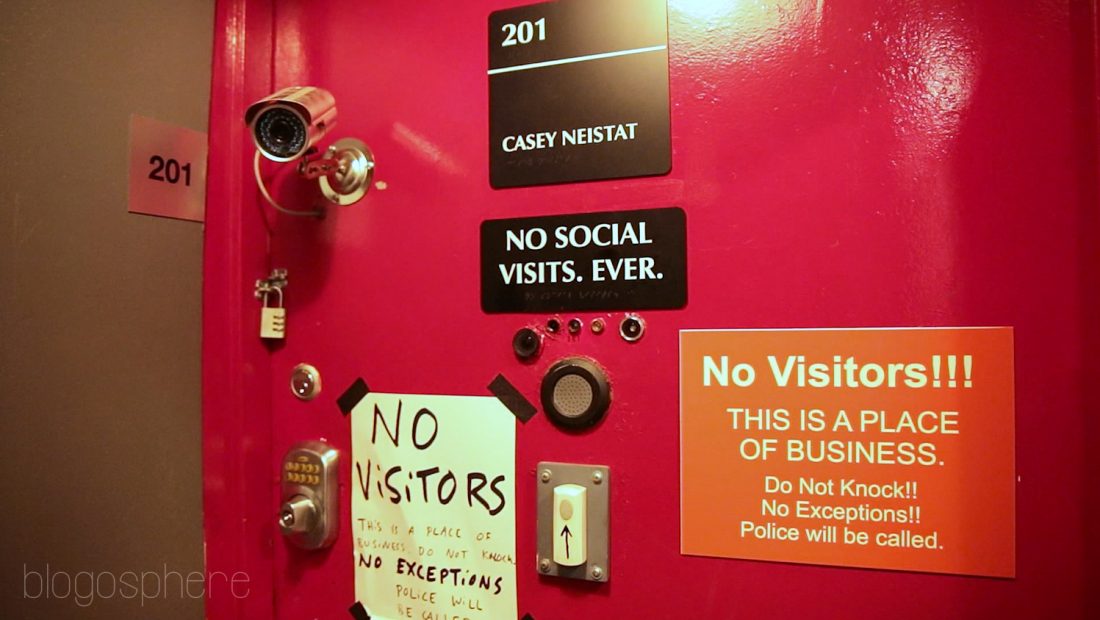
From research, I’ve noticed that keeping Casey still during interviews can be quite tricky – he bores easily and if you lose his attention, he tunes you out/gets up and does something else – like shutting a door, turning off a light, getting some water – before returning. Apparently Mark Zuckerberg is the same.
The longest I’ve seen Casey sit still for – interview-wise – is in Philip De Franco’s podcast (which was also filmed and put on YouTube) and towards the end, you can see him getting uncomfortable and restless.
“We’re ready,” I announce to Casey once Duncan has given me the go-ahead. “Great,” he responds and puts on a pair of his trademark glasses. He comes over, pulls up a chair in front of the camera and says, “Ready”.
With the time – or lack thereof – in mind, the added pressure of knowing we’ve flown across the world for this very moment and that it has to go well, and now feeling decidedly unnerved by the human before me, I take a deep breath breath and start…
Alice: “Right Casey, let’s begin. What does success look like to you?”
Casey: “I think success has always been a fairly nebulous term. Success is always in the eye of the beholder. For me, the only metric of success is happiness – so how much of your life do you spend doing things that make you happy versus how much of your life do you spend doing things that you hate and that make you miserable.
“I’m pretty cognisant of that equation and I think right now I’m at a place where 70% of the time I’m doing stuff that I love and 30% of the time I’m fucking frustrated and angry all day long.”
‘We must have picked a 30% of the time day…’, I think to myself.
What is a relief, however, is how precise and quotable Casey is. He answers questions fluently and he uses the type of words usually reserved for the pages of thesauruses, naturally. Terms like ‘nebulous’ and ‘cognisant’ sit neatly in his vernacular and manage – remarkably – not to sound pretentious. So yes, we may not have that much time, but we will get an interview. I’ll just need to get through the topics fast.
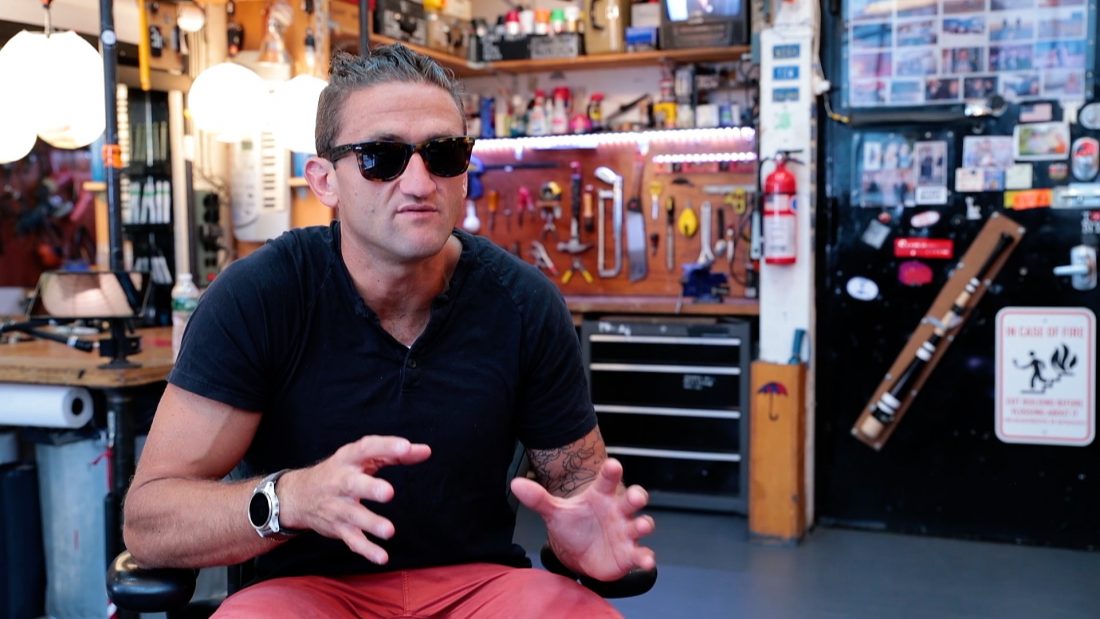
A: “What’s making you angry?,” I continue. “What’s happening in that 30% of the time?”
C: “It’s like going into the department of motor vehicles to renew my driver’s license – I don’t want to do that, but that’s like a necessity.
“And right now, in terms of what I’m doing in my career, I’m in a real transitional time – in what I’m doing in media and everything else and it’s a lot of building out infrastructure, which is a lot harder than just doing.
“When I think back to when I was doing the vlog every day, I knew exactly what I was doing and I could just do it, and that was 90% doing what I love.
“But then when I look back to when I had really shitty jobs to pay the bills, you know 80% of my waking moments were spent doing something that I hated, which is working for someone else doing something that I don’t necessarily believe in. So I think where I’m at is a great place and I would never complain, but my goal is always to reduce spending time doing shit that I hate to as little as possible.”
A: “Could you not get someone else to do the stuff you don’t like?”
C: “No, the world doesn’t work that way. I think that’s one of the great myths of the world – there are things that you just have to do yourself, things that you cannot delegate.
“When it comes to thinking and working things out that’s something you have to do yourself, you can’t assign it to anyone else.”
A: “In general, do you think that you can delegate?”
C: “Yes, we have 30 people working downstairs at Beme [Casey’s company] – that’s a lot of hands all working together to try and make something that’s great. The only way to get bigger than yourself is to work with others, but that doesn’t always simplify things or make things easier.”
A: “Yeah, that makes sense. Now, we’ve spoken a bit about success – on the flipside, what about failure? Would you say that you’ve ever failed? Or does failure actually ever exist – because you always learn from it…”
C: “Well, sure. Not to sound too platitudinal. I think that failure is part of the process, I think it’s when you give up that you fail.
“I think failing along the way or little failures are just part of the process, and I think if you try to avoid those and are too scared of those little pitfalls you’re never going to get anywhere. You have to accept failure as part of the process.
“And when I look back at the trajectory of my own career or my personal life or any aspect of my life in general, it’s ebb and flow, it’s up and down. All of it. Including my own physical health – I used to smoke two packs of cigarettes a day, like that’s when I was failing at being healthy.
“I’m really into running right now – I’m succeeding at being healthy, but I didn’t stop when I was 25 and smoking two packs a day and be like ‘oh, that’s it – I’m unhealthy now forever’ – that would be failing.
“I think I’m pretty resistant and resilient to giving up because I’m hyper aware of what the alternative is.”
A: “Which is?”
C: “Accepting failure and being a fucking loser.
“People who give up are losers – make no mistake – and I don’t want to be that person.
“I have a good friend, his name is Quentin, and Quentin is a movie star, he’s a celebrated author and he’s friends with all sorts of other movie stars and celebrities, he’s a celebrity in his own right and he had his own TV show and is a wildly successful guy – and he spends his days in a wheelchair, is completely immobile, and if he’s taken off of oxygen he could die; but he hasn’t fucking given up. So if somebody like me is going to sit back and say ‘it got too hard so I gave up’, that makes me a loser.
“So just to qualify what I mean when I say people who give up are losers, that’s what I mean. There’s always someone who has less, who hasn’t given up. So if there’s something you really want, fucking get it. Or don’t talk about it.”
A: “In terms of going out and getting/doing the things we want, do you ever get frustrated with the amount of people who ask you – and also sort of rely on you – for motivation?”
C: “I have a fairly nihilistic perspective on that, which is nobody gives a shit about you.
“I say that having spent my career always looking to other people for advice and help, and if it weren’t for other people elevating me, I would never have got to where I am. So I know that that’s a wild contradiction there, but the juxtaposition between those two understandings is where reality lives – if you work hard and believe in what you’re doing, you will invariably run into people who appreciate that in you, as I do in others, and I want to be a part of that to help elevate. But the reality is, if you’re someone who’s waiting for that to happen and react to someone elevating you, you’re never going to get anywhere.
“I like to live somewhere in the middle. I get 100 emails a day from people saying ‘can you help me with this’ and most of them just get deleted without being read because I think if you’re going to ask somebody for help and the only effort you’re willing to demonstrate is the easiest thing in the world – sending an email – no.
“When I look back at the people who have helped me, like developing deep, dynamic relationships with these individuals and when I look at the trajectory of my career, I don’t see 10,000 people that I emailed asking for help, I see five or six people, who really became a big part of who I am – and there was a symbiotic relationship – they were able to help me and I hope that I was able to help them with some things in exchange.”
A: “I think in terms of being an entrepreneur there’s a lot of emphasis from people saying ‘start with finding a mentor’, but actually you need to be out there doing your thing and then that’s when the person will arise – and that you shouldn’t spend lots of time trying to find someone to help you. Do you agree with that?”
C: “Yeah, I think mentorship is an often misinterpreted thing. I think that if you’re looking for someone else to show you the way, then you’ve already failed.
“I think that mentors/advisors/education/experiences can all be wonderful guides to push you and promote what you’re trying to do, but ultimately if you don’t have a vision for something or an insatiable desire to realise or achieve that, no external force is going to get you there. All those factors are really important but a distant second behind your own conviction to realise something.”
A: “And then in terms of family, obviously they’re your number one priority. How supportive are they in terms of your career?”
C: “My family is supportive. Without Candice [Casey’s wife] helping me, I never would have been able to do what I’ve done. “And I credit my family with much of my success, but I think the role that family plays in being successful is much more intrinsic to who I am, which is like I had a kid when I was very young, so I always had someone else who I put above myself – like my kid, my baby – who’s now a teenager – he was always a bigger priority than me.
“I always cared about him being happy above myself being happy, I cared more about him being fed than me being fed, he was a greater priority. So my family is my sense of purpose, they’re the reason why I do anything, so my ambition and my goals and everything I do in life is fuelled by my family who I love so much.
“When I think about the role they have in what I do it’s that – they’re my purpose. And for me, that’s so much more important and more substantial than the advice Candice gives me about the things that I’m doing or the support she gives me to show up to work every day.”
A: “You mentioned that you had Owen when you were very young, you’ve kind of had – would you say – two sets of fatherhood because of the age gap between your children. How have you changed as a father?… Obviously your circumstances have changed a lot…”
C: “I think the difference is when I had Owen, my first kid, I was a teenager and I had nothing. I was dirt poor and had no money and no real career, I had nothing, so I had to raise him without anything, and now we have a lot of resources – so that’s a really interesting dynamic of what it means to raise a kid when you have nothing versus what it means to raise a kid when you have access to a lot of things.
“In some sort of cruel and ironic way, it was easier when we had nothing because there were no options. Now we have a lot of options and are constantly questioning ourselves – are we spoiling her [Francine]? Are we doing the right thing?’
“Make no mistake, it’s much better to have options, it’s better now, there’s a lot less worrying now, but as far as what makes them a better person, if I didn’t have struggle in my upbringing, I don’t think I’d be the person I am today.
“When I look at Owen – my son – he gets straight A’s in college and is an exemplary student, who works so hard – I attribute a lot of that to the fact that he struggled with me when we were young, and Francine has a very privileged life and I’m not sure what the right thing to do there – as a parent – is. But I’m always appreciative of how fortunate we are to be able to afford that life for her.”
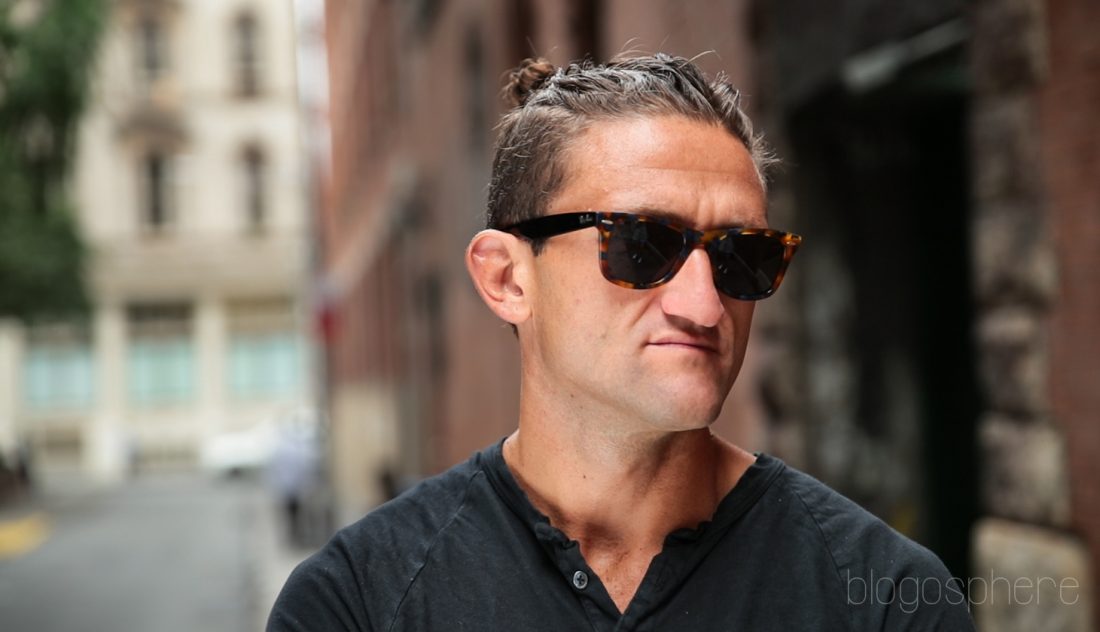
A: “That life has been enabled through your business and also YouTube. What are your views on the creator industry today? And how do you define yourself – would it be YouTuber, or entrepreneur, or lots of different things?”
C: “I’ve never really subscribed to any one thing. I used to wear a hat that said filmmaker on it, but I never really used film. I used to make videos on cameras or my cellphone and video cameras and I like YouTube as a place to put the content.
“I bounce around. I think when I was doing daily content [on YouTube], I was seen as a YouTuber, a title that I was really very proud of, but my relationship with the platform now is a little different – I see it as a great place to distribute what I’m making at any given point in time. But as my relationship with my audience shifts and changes as does the role that I think I have on the platform.”
A: “What is it that you love about the platform and the industry?”
C: “I love the romance of how anyone now, ostensibly – for the most part, anyone now who has a cell-phone can shoot a video and gather ideas and their perspectives and distribute that to a global audience. Like that’s crazy to think of.
“A pencil and paper has always been available to people – you can always be a writer – it doesn’t mean that there are a lot of good writers but you’ve always had the pencil and paper.
“Paint brush and canvas, almost anyone can access that, but it doesn’t mean that there are lots of good painters.
“And now, finally, for the first time in history ever, filmmaking has become an accessible medium, it’s become a truly egalitarian artform, which means anyone can do it for any purpose and like now they’re called creators rather than filmmakers and I love that. I love that it’s been completely democratised so everybody can partake and if you have a voice or a perspective on something that people want to see then you can find your audience in the space.
“That very romantic vision of it is why I’m so passionate about it and why I love YouTube so much because it’s the beacon in that space right now.”
A: “Your content specifically has inspired a lot of people and you’ve spoken a bit about originality before, but where is the line between inspiration and imitation for you?”
C: “One, to succeed on YouTube you have to do something that’s new. I can say that ad nauseam, but I don’t think people really grasp that.
“I think the reason why they don’t really grasp that is creators who get their start on YouTube are, by definition, novices.
“I had a background in feature films and short films and television before I brought all of that understanding to YouTube, but most people on YouTube want to make YouTube videos and they don’t know what to do, so they look at what they like seeing and they try to emulate that and I think it’s unfortunate because if all you’re doing is a less good version of what someone else is doing, you’re never going to find your voice or be successful.
“So I understand it, I think it’s frustrating, and I think it’s easy for people like me to say ‘do your own thing’, but it’s also very hard for someone who’s never had any experience in this space to invent their own medium out of thin air, so I don’t know what the answer to imitation versus inspiration actually is, but I do think it’s a reality of a platform like YouTube because of the very nature of how it works.”
A: “And through your content, you’ve become famous. You get people coming to your office and knocking on your door… what are your views on boundaries?”
C: “When your job is to make something creative and share it with the world, the more people who choose – on their own volition – to engage and watch it, that is a metric of success.
“If people care about what you’re writing, and reading what you’re writing, that means you’re a successful writer. So the more people who engage and watch my content makes me feel good because people are choosing to engage with what I’m making – that’s tremendous.
“And that part of the notoriety and fame of YouTube is extremely motivating and then I think the boundaries – or lack thereof – that’s part of it. You can’t have one without the other.
“That doesn’t necessarily mean it’s always easy to deal with, sometimes it’s hard to deal with, but I think that it’s a reality of putting yourself out there.
“There will always be people who really don’t have much of an understanding or respect for boundaries and they overstep them – sometimes maliciously and sometimes due to an ignorance of what is appropriate. Again, I think that is just a reality of putting yourself out there.”
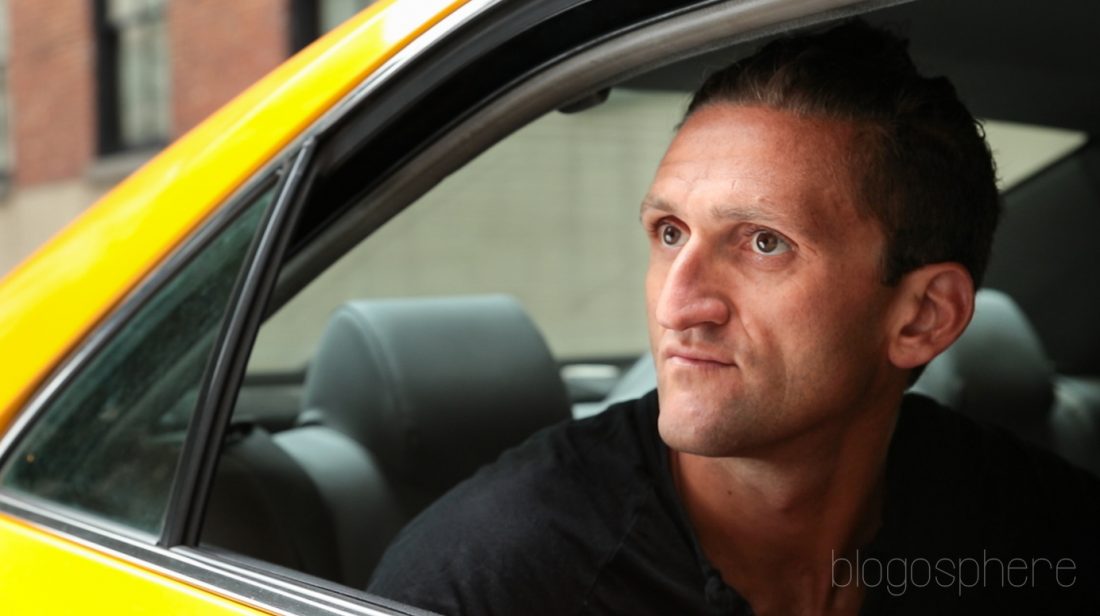
A: “And in terms of your fame and Beme News are you worried about scalability? I know that you’ve mentioned that you don’t want it to become the Casey show.”
C: “I think as long as it’s just about me, it can’t get any bigger than me, and that would be unfortunate. Certainly my YouTube channel is just about me, by definition that’s what it is. At Beme, because we have more resources than just me and a camera, we can build something that is scalable. And that’s what we’re doing.
“And that’s why I love all of the individuals who we work with who are researchers and producers and have more formal journalistic backgrounds, but I also love that we’re still working with other creators in there because they’ll help me build something that’s bigger than any one individual personality.
“I think that people’s interest in me is what will bring them to that platform and then what they find there is going to be bigger than me and they can choose to like that or not like that.”
A: “People are definitely interested in you and Beme News, and the stuff you’ve released is really informative and educational. Speaking of education, how important do you think it is in terms of becoming an entrepreneur?”
C: “Education is not a barrier to entry in the world of entrepreneurship. An education is something virtuous that I believe in, it’s something that is a way to fast forward and to attain what would otherwise… necessitate experience to gather.
“It’s taken me a life of experience to attain the level of experience and understanding that I have and I think school and formal education is a great way to expedite that process – learn a lot in a short amount of time.
“But I also think that education can be a liability. I think when entrepreneurs want to be entrepreneurs and rely too heavily on education they can become a crutch. To assume that you can be taught how to do something that there is by definition no trajectory for, no predetermined path through, I think couldn’t be more wrong.
“And to be a successful entrepreneur means to pave your own way, to do something that didn’t exist before you. You can’t be taught to do that. So education is a tool; a very, very powerful tool but if you don’t know how to swing that hammer properly then it’s not going to serve you.
“And I think that’s often where there can be misunderstandings and misalignments in the role that education plays in being a successful entrepreneur. Because I have this, I’ll be successful there – and that’s not the case at all.”
A: “And then I wanted to talk to you about your Hollywood Reporter cover, which featured five entrepreneurs – all of whom were men. You’ve mentioned before that when it came out you were a bit disappointed at the lack of diversity, could you expand on that?”
C: “I just thought that was a bit frustrating because at CNN in particular it’s a company that is powered by incredibly capable and powerful women. And I think that much of what that company does and its success that it has is because of the diversity that is the backbone of that company. So it was just a bit of a bummer to see that that wasn’t represented there and that’s where that frustration came from.”
A: “Do you think that within the creator space there are so many successful women because, unlike with more traditional careers, there isn’t that typical male boss and rather than having to be promoted up the usually patriarchal ladder, women can make it by themselves… Why do you think there are so many successful women in the creator space?”
C: “I think women are successful there because of the same reason that men are successful there, the same reason why there’s such diversity on YouTube – because a unique voice finds a unique audience for that voice.
“I think that there’s an appetite for people to hear from women from all walks of life on YouTube, the same way that there’s a desire to hear from all different types of men.
“And then there’s the proliferation of the LGBTQ community on YouTube, which has really found its voice because there’s such a tremendous audience for that. I wouldn’t say it’s unique to women, but again I think that is one of the virtues of YouTube – that because it can connect what was such a unique voice and perspective to its audience – it elevates voices that, certainly before the internet and YouTube, didn’t have a home.”
A: “Back to your success. I know we’ve touched upon inspiration versus imitation, but irrespective of that there are a lot of people who do try and emulate your lifestyle. And your lifestyle – the limited sleep, time spent working and running, is sort of ‘superhuman’. Do you sometimes worry that, as a role model, the life you lead isn’t really obtainable or realistic for most people?”
C: “If you’re trying to find success by trying to emulate what other people are doing, you’ve failed to launch entirely.
“I like to share what I do that makes me happy; running makes me happy, making things makes me happy, being with my family makes me happy, managing makes me miserable, going to the department of motor vehicles makes me miserable, so I like to put those things out there, like the books that I read and the YouTubers that I watch and the movies that I watch.
“I pluck and I keep all of the things that I like, and I like to share the things that motivate me versus everything else. And I think that is a good way to be.
“If people see me running and it gets them excited about being more physically fit then that’s a fantastic thing. But it takes years to get ready for a marathon, so if people see me run a marathon and try and do it the next day it’s probably not going to work out too well.”
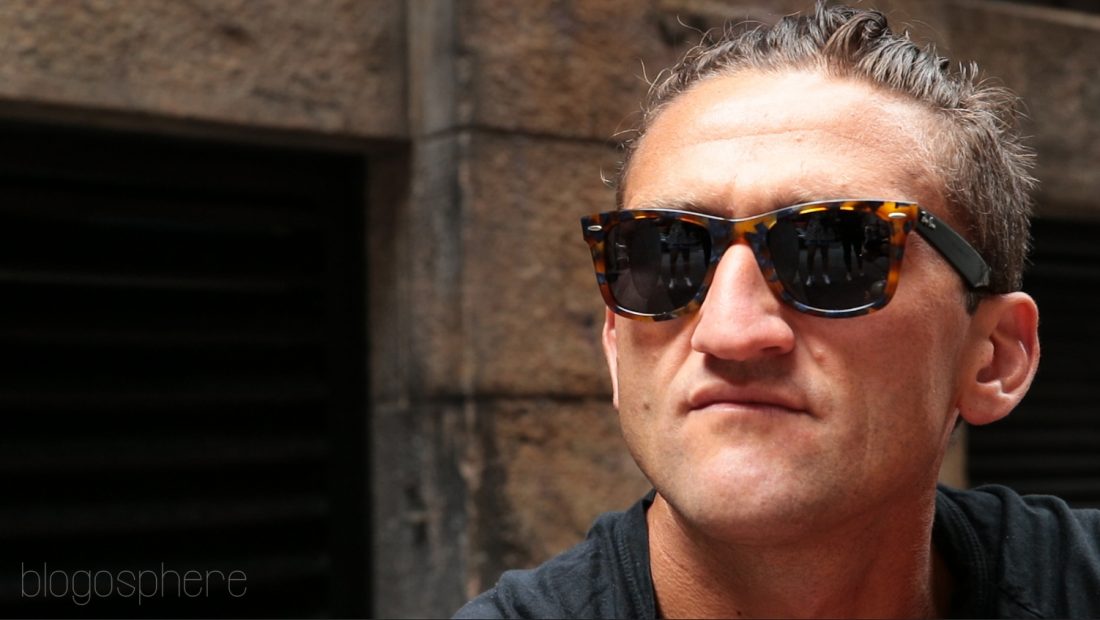
A: “And exercise is so important for mental health. If you’re doing so much academic and business work, it’s a great way to unwind. Is running something you do for your mental health?”
C: “Running for me is a cerebral activity meaning it’s purely a brain activity, it’s not a physical activity, and the top part of living in a city with 20 million people is that you’re never alone, you never get time just to think and that for me is what running is, it’s my time.
“So, I would say that beyond the physical benefits of me being healthy that’s what I love most about it; having a couple of hours every morning to just be alone and think about what bothers me. It’s also the place where I get the most frustrated when people try to stop me to ask for a selfie.”
A: “In terms of living in a city with 20 million people, you have suggested before that you might not stay in New York for that much longer. Could you live in a quieter place – not have that buzz?”
C: “I’m a real believer that life is lived in chapters. If you don’t turn the page, you’re never going to figure out what comes next.
“I feel like my chapter in New York City is fading, I think New York is a really awesome place if you’re young and broke, or old and rich.
“And I’m a married dad with two kids, I don’t go out and party – I just like to exercise and work and be with my family – I don’t know if New York is the best place for that.
“But there’s no other place on planet Earth that I could do what I’ve done in my work and personal life in the last decade other than New York City, but I’m past that now.
“I like to work, I don’t like to go out and party. I like to spend time with my friends, I don’t like to go out to bars. I’m not taking advantage of what this city uniquely possesses and I’m doing that and paying a great price to live here, which is being around all this chaos all the time.”

A: “Mmmn, London is pretty expensive too. Right, onto my penultimate question, what would you like your legacy to be?”
C: “I don’t know. That’s a very difficult question. I don’t think it’s ever a good time to guess, or premeditate or put too much time into thinking about your own legacy, you don’t get to determine your legacy other people decide that for you.
“I like to focus on now and what’s important to me and concentrate on being the best person I can be, and if that yields a legacy that someone else determines to be one that bettered the world then great, if not that sucks – but I’ll try harder next time.”
A: “And finally, what do you think the future of the content industry is going to be?”
C: “I think the future of media in general is going to gravitate much more towards individual creators – I think we’re going to see individual content creators with their own YouTube channels with audiences that are much bigger than anything on television – it’s indicative of where appetite for viewers is headed and where creative direction is headed.
“I think in a couple of years the media space in general is going to look a lot more like YouTube and a lot less like the TV that I grew up with; flipping the channel to watch something more interesting.
“I think whatever is next isn’t going to be to do with virtual reality or tech, it’s going to be with distribution.
“I think there’s a potential for something that looks like a decentralised YouTube in the next three, five and seven years that’s much more compelling and to do with micro-payments and transactions, where you put something out there and everytime someone clicks watch there’s an automatic micro-payment structure built into it – but I don’t think it’s going to be a gimmick like a VR or something you strap on your head, I don’t think it’s headed in that direction.
“I think it’s something that – for the end consumer – is going to feel a lot like what we have today. But all the underlying technology will be a lot more compelling and interesting than how it is today.”
Today. Our day – well, two hours – in New York with Casey Neistat.
“Right, that’s it,” I say and turn off the Dictaphone. “Interview done.” It’s taken 32 minutes and 53 seconds. We have 1 hour 27 minutes and 47 seconds to take eight photographs.
Casey has already returned to his computer and emails.
Throughout the interview, he’s sat still – but now that there’s a slight pause (for video camera to be dismantled), he’s taken the chance to move into doing something more productive (emails). Casey evaluates everything, determines where his time is best spent and uses every second to be his most efficient.
When he commits to something, he gives it 100% of his energy. He’s not a multi-tasker in the sense of doing things at the same time, he allocates a period of time to a task and then does it – properly. Then he moves on – sometimes impulsively – to the next task and so on and so forth. You get the impression that even a second not allocated to being productive frustrates him – he never wants to feel like he’s wasting time. Steve Jobs once said, ‘Your time is limited, so don’t waste it…’. Casey definitely doesn’t.
Back in the office, Duncan has packed down his video equipment and we’re ready to start shooting. Linda and I have decided a shoot will work well. New York being the city that – like Casey – never sleeps…
I announce that we’re ready and Casey gets up. “Great.”
Linda and I have done a recce of the area the day before, and knowing that we only had two hours, have planned each photograph. We have 10 minutes per shot.
We head downstairs and out onto Broadway. It’s overcast, but thankfully the rain that has been pouring down all morning has paused. I’m in charge of the bounce board to try and direct any possible sunlight onto Casey (the logistics of getting permission to use lights when shooting outside in New York are a nightmare, FYI).
A few seconds of being on the street, however, and the bounce board takes on a new purpose – that of a barrier between Casey and his many, many fans. We hadn’t anticipated just how quickly they would appear. Granted, we’re right outside his office, but still…
“Casey, I love you.”
“Casey, your videos are the best!”
“Casey, you’re awesome!”
“Oh my god, Casey – can I get a selfie!”
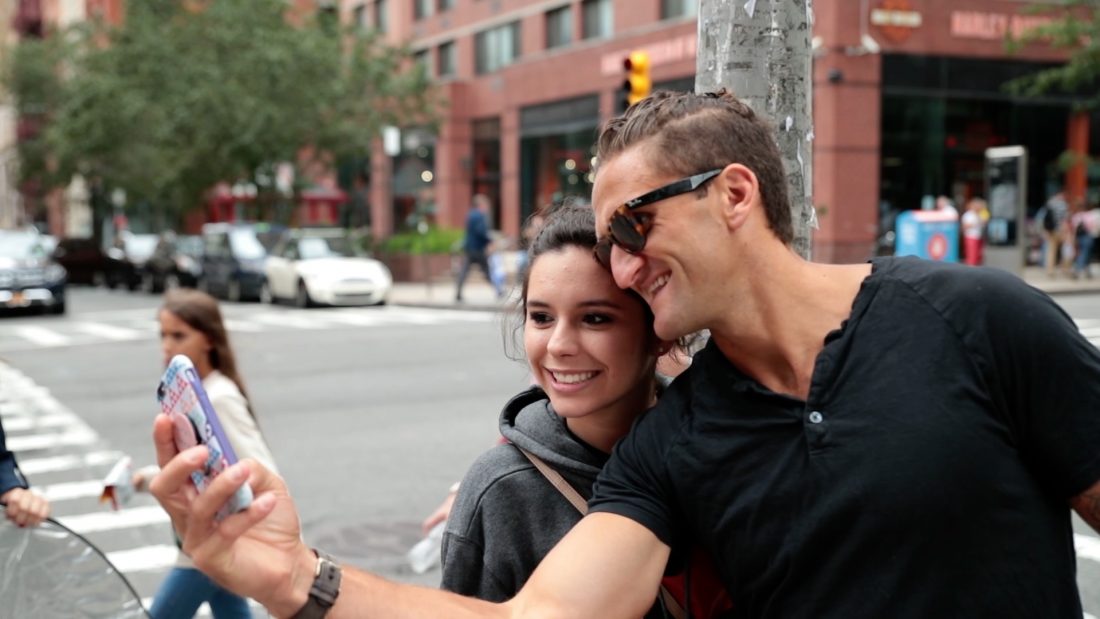
The latter is the most prevalent request – and one that is really eating into our 10-minute window per photograph. When people ask Casey for their selfies, his response is “Sure”. Then, deadpan, he takes their phones from them and quickly takes the picture before handing the phone back. He is in control of each and every selfie.
I start maneuvering the bounce board to separate the growing group of fans, and Linda starts to snap away. We have a vintage small globe as a prop, which we want Casey to hold for the cover shot (to highlight his love of travel and adventure). Linda hands it to him and asks him to hold it – no sooner than it is in his hands, he’s thrown it up in the air, caught it, then thrown it onto the road in an attempt to bounce it… It’s solid and cracks in half.
We move on from that shot. The next few come in quick succession; we get him to cross the road holding an umbrella, then lean against a lampost. More people are coming out of their offices now to get a glimpse of him, and it’s beginning to get too much. We bank the shots we wanted on Broadway and then take to a nearby backstreet.
Here, we hail a cab – get two shots in it, move on to the skateboard shot, quick portrait, sitting down on pavement and it’s a wrap. Two hours, seven minutes. A Blogosphere cover shoot record – and not one that I’d be keen to replicate.
Now, all that’s left is collecting our bags from the office. Our short time with Casey Neistat is coming to a close.
Back in the office, Duncan and Linda pack up their equipment (I’ve managed to lose Linda’s bounce board case outside). As they zip their bags shut, Casey turns to me, takes off his glasses and says:
“So, tell me a bit more about Blogosphere.”
I keep it short, sharp and to the point. I tell him how it started, that we’re considering investment and our plans to scale the B2B arm of the business. He looks directly at me when I’m speaking, and for a brief period of time I feel like I’ve actually got his full attention. He’s engaged.
In that moment, I look into his eyes, so often hidden behind lenses, and get a glimpse into the inner workings of this meticulous man. He’s intense, he’s powerful, he’s captivating, he’s on a alternate wavelength. He’s different.
And then it hits me. Casey Neistat’s qualities in a list:
- Intelligent
- Fearless
- Confident
- Ambitious
- Impulsive
Tick, tick, tick, tick, tick… His behaviour all starts to make sense: Casey Neistat isn’t just ‘cool’, ‘game-changing’ and ‘inspirational’. Casey Neistat is a sociopath.
A high-functioning one, yes, but a sociopath nonetheless.
I pause, contemplate the diagnosis and realise that – like millions of others – I’m still a fan.

